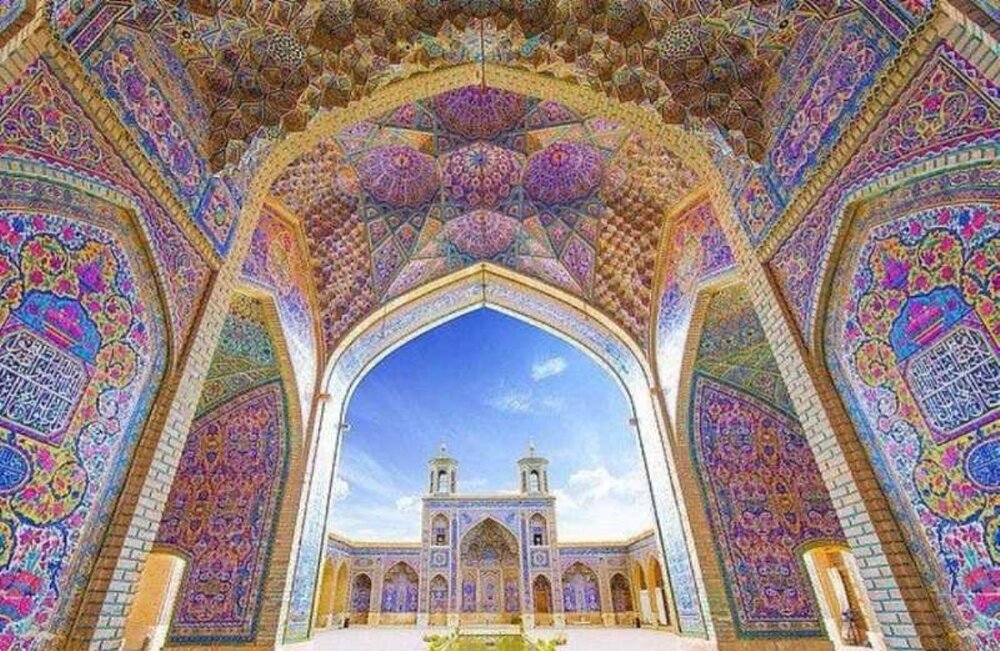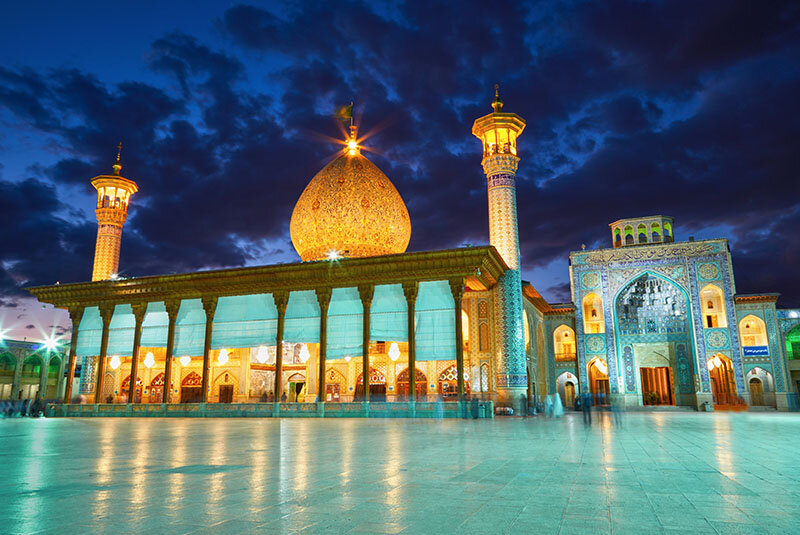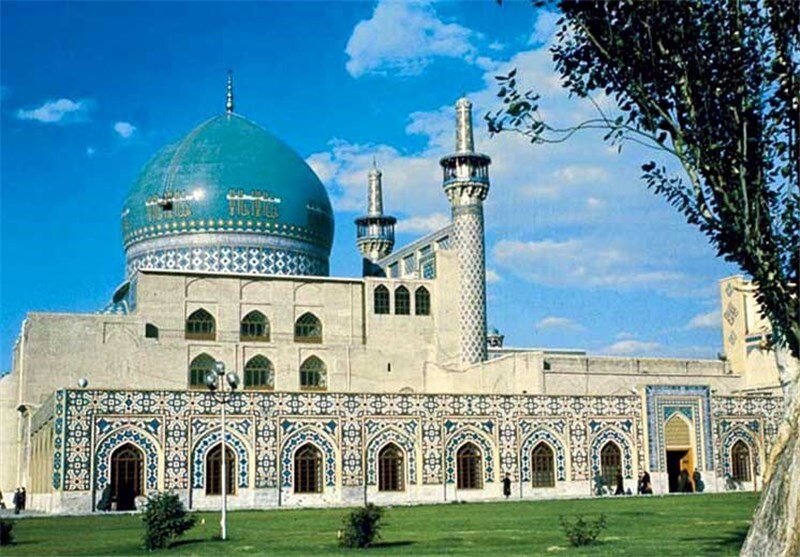Ten gorgeous mosques to visit in Iran

TEHRAN – Cascades of photogenic domes and minarets can be seen in every corner of Iran as inseparable elements of mosques some of which widely known as timeless benchmarks of the Islamic architecture.
Mosque, locally called masjed, or masjid (“a place of prostration” to God), is any house or open area of prayer in Islam. Generally speaking, the architecture of mosques in Iran is a combination of symmetry, geometric designs, and vibrant colors.
The architecture of the mosques in Iran varies from one region to another, due to geometric structures, materials, and styles specific to each location. These mosques often have very complex structures in which color variations, tiles, and symbolic designs are used.
Islamic architecture, building traditions of Muslim populations from the 7th century on, finds its highest expression in religious buildings such as the mosque and madrasah. Early Islamic religious architecture, according to Britannica, exemplified by Jerusalem’s Dome of the Rock (691 CE) and the Great Mosque (705) in Damascus, drew on Christian architectural features such as domes, columnar arches, and mosaics but also included large courts for congregational prayer and a mihrab. From early times, the characteristic semicircular horseshoe arch and rich, nonrepresentational decoration of surfaces were employed. Religious architecture came into its own with the creation of the hypostyle mosque in Iraq and Egypt. In Iran a mosque plan consisting of four eyvans (vaulted halls) opening onto a central court was used.
Below is ten must-see gorgeous mosques you cannot easily miss while traversing the Islamic Republic:
Nasir Al-Molk Mosque, Shiraz
This is probably the first image coming to your mind when we talk about Iranian mosques. It is also known as Pink Mosque, because of pink color tiles for its interior design. When standing outside the mosque, you cannot guess what waits for you inside. Just step in and see the magic of light and color.

The mosque was constructed during the Qajar era, over the course of 12 years during the late 1800s, but restoration and maintenance efforts continue today. The mosque was built by the order of Mirza Hasan Ali Nasir Al-Molk, and it is designed by Mohammad Hasan-e Memar.
Sheikh Lotfollah Mosque, Isfahan
The Sheikh Lotfollah Mosque is a stunning example of intricate Iranian architecture, standing tall since the early 17th century. The design of the building itself is rather simple, but the tile work makes it well worth the visit.

Sheikh Lotfollah Mosque is best recognized for its defiantly off-center dome and lack of minarets. The cream-hued tiles shift colors as the sun moves throughout the day, giving them a pinkish tint at times.
Covered in vivid colored tiles inside and out, its dome is without a doubt the focal point of attention with its arabesque designs that become smaller as they approach the center.
Shah Cheragh Mosque, Shiraz
Shah-e Cheragh (“King of Light”) is a major mausoleum and pilgrimage site in the touristic city of Shiraz, southern Iran.
The dazzling shrine of mirrored tiles is where Sayyed Mir Ahmad, one of the brothers of Imam Reza (AS), is laid to rest. Each day, it draws hundreds of the faithful from all over the country or even abroad.
The mausoleum boasts architectural elements and motifs from various centuries and its courtyard and tilework represent relatively modern embellishments from the late-Qajar period. Its blue-tiled dome is flanked by dazzling gold-tipped minarets.

There is also a modest museum in the northwestern corner of the courtyard, next to the shrine, which showcases shrine-related objects, including some highly prized old Qurans and an exquisite door embellished with silver and gold.
Visitors are welcome to enter the courtyard in the middle of the complex but the entrance to the shrine is not usually permitted to non-Muslims. Photography with large digital cameras is not permitted.
Imam Mosque, Isfahan
The Imam Mosque is situated on the southern side of one of the most beautiful squares in Iran; Naghsh-e Jahan Square. The mosque is an excellent example of Islamic architecture in the country which has been listed as a World Heritage Site by UNESCO along with other monuments at the square.

The mosque dates back to the 1600s. It's made of mosaic tiles of seven different colors and is considered as one of the most stunning examples of Iranian architecture. It has four towering minarets, 18 million bricks, and hundreds of thousands of tiles. The ornamental entrance of the building is packed with colorful mosaic tiles and elaborate inscriptions.
Sheikh Safi al-Din Khanegah and Shrine Ensemble, Ardabil
Sheikh Safi al-Din Khanegah and Shrine Ensemble is a microcosm of Sufism where arrays of harmonious sun-scorched domes, well-preserved and richly-ornamented facades and interiors, and, above all, an atmosphere of peace and tranquility have all made a must-see stopover while traversing northwest Iran.

The ensemble is named after Sheikh Safi al-Din Ardebili (1253-1334), who was a Sufi philosopher and leader of Islamic mystic practices. It embodies the essence of Sufi traditions by having a microcosmic ‘city’, which embraces a mosque, a madrasa, a library, a cistern, a bathhouse, kitchens, a hospital, as well as religious houses amongst others. The place also boasts a remarkable collection of antique artifacts.
Jameh Mosque, Yazd
The terms “Jameh Mosque” or “Masjed-e Jameh” or “Friday Mosque” is used in Iran for a grand communal mosque where mandatory Friday prayers are performed: the phrase is used in other Muslim countries but only in Iran does it designate this purpose.
The mosque, which was first built under Ala’oddoleh Garshasb of the Buyid dynasty, is still in use today and is a fine example of Persian architecture.

The entrance to the mosque is crowned by a pair of minarets, one of the tallest in Iran, dating back to the Safavid era and measuring 52 meters in height and six meters in diameter. The entrance is decorated from top to bottom in tile work, which is formed of different colored pieces that are sandwiched together to create the design.
Within is a long arcaded courtyard where, behind a deep-set south-east iwan, is the sanctuary chamber. Its tiled Mihrab is one of the finest of its kind in existence.
The architectural masterpiece was inscribed on the National Heritage List in 1924.
Blue Mosque, Tabriz
The Blue Mosque, known as Masjed-e Kabud in Farsi, is one of the valuable historical monuments of Iran that its special architectural style has distinguished this magnificent building from other similar examples.
Covered in spectacular blue tiles, from which it derives its name, the Blue Mosque is also an example of Islamic designs and decorations as there are kufic, naskh, and thulth scripts as well as various arabesque and geometric patterns inside.
Also called the turquoise of Islam due to its beautiful blue tiles, the mosque was completed in c. 1465 and is remarkable for its simplicity, brickwork, and a great size as well.

The mosque survived a devastating earthquake in 1727. However, many parts of it caved in due to a quake struck later in the same century. Many parts of the structure were rebuilt in 1973.
The missing tiles of the mosque’s façade are also a reminder of the scars the mosque bears from the damage it suffered from the quakes. Some visitors say “From the outside, it looks first a bit disappointing but the interior is beautiful and worth the entrance price.”
In the southern part of the mosque lies a time-honored mausoleum, itself a source of splendor. It is entirely covered with massive marble slabs on which verses from the holy Quran have been engraved with a background of fine arabesques.
Apart from its unique architecture and history, a play of color and light that shines through the mosque’s windows, gives photographers a great chance to take unique artistic photos.
Goharshad Mosque, Mashhad
The great mosque of Goharshad is a remarkable Islamic structure due to its age, architectural characteristics, and rich tile decorations. Made of brick and plaster in the 15th century, it used to be served as a free-standing mosque and currently serves as one of the prayer halls within the splendid Imam Reza Shrine Complex in Mashhad. On the margins of the main veranda’s entrance, there is an old inscription carved by calligrapher Baysunqur Mirza.
This comprehensive deed of endowment suggests that the mosque was built when Shahrokh, the Timurid king, was on the throne. The construction started in 1418 by the order of Queen Goharshad, the wife of Shahrokh. It took about 12 years to be completed under the supervision of capable Iranian architect Ghavameddin Shirazi by the use of the architectural and decorative manpower supplied from the Iranian cities of Shiraz and Isfahan.

Covering an area of 9410 square meters, the mosque consists of a large azure dome, two 40-meter minarets, four verandas, a courtyard with seven big bedchambers, and a large altar made of a stony dado and mosaic faience shell.
Standing in the courtyard one can recognize the ensemble’s exuberant color and solidity among the tower-like minarets, merging with the outer corners of the portal screen extend to the ground together with the high foundation revetment of marble.
Vakil Mosque, Shiraz
Masjed-e Vakil (Vakil Mosque), which is part of a bigger 18th-century ensemble, may be tantamount to a trip to Istanbul while missing the Blue Mosque. The atmospheric ensemble of Masjed-e Vakil, Bazaar-e Vakil, and Vakil Bathhouse has always been a bustling tourist destination in downtown Shiraz, and a must-see for both local and international backpackers.
The mosque is connected to the bazaar and almost attached to the bathhouse with a lane in between. As one enters the mosque, they can see a corridor leading to the Vakil Bazaar on the left-hand side.
Karim Khan Zand, the founder of the Zand Dynasty who ruled from 1751 to 1779, ordered the construction of the ensemble in the 18th century, as part of his grand development projects in the heart of his capital city.

The mosque has a recessed entrance decorated with Shirazi rose-pink tiles, a splendid inner courtyard surrounded by beautifully tiled alcoves and porches, two vast iwans (porticos), and a pleasingly proportioned 75m-by-36m vaulted prayer hall. A distinguishing feature of the mosque, however, is the forest of 48 diagonally fluted columns that support the prayer hall, displaying a hypnotic rhythm of verticals and arabesques.
Agha Bozorg Mosque, Kashan
Masjed-e Agha Bozorg (Agha Bozorg Mosque) is simply one of many top destinations in central Iran that lure not only the faithful but travelers and architecture buffs.
Standing tall in the oasis city of Kashan, the 19th-century mosque boasts a pleasing symmetry in its traditional design that is embellished by intricate plasterwork, woodwork, mirrorwork, and geometric tilework patterns.

A tribute to the Islamic architecture, the mosque delicately takes elements of Persian architecture as well.
The massive structure includes several congregational halls, adjoining arcades, tiled minarets, massive badgirs (wind towers), and an austere dome. The mud-brick walls, arches, and ceilings are covered with Quranic inscriptions and mosaics as well.
Narratives say that the mosque is named after Mulla Muhammad Mahdi Naraqi (1715-1795) who was nicknamed “Agha Bozorg” for being a Shia philosopher and theologian.
AFM/MG
